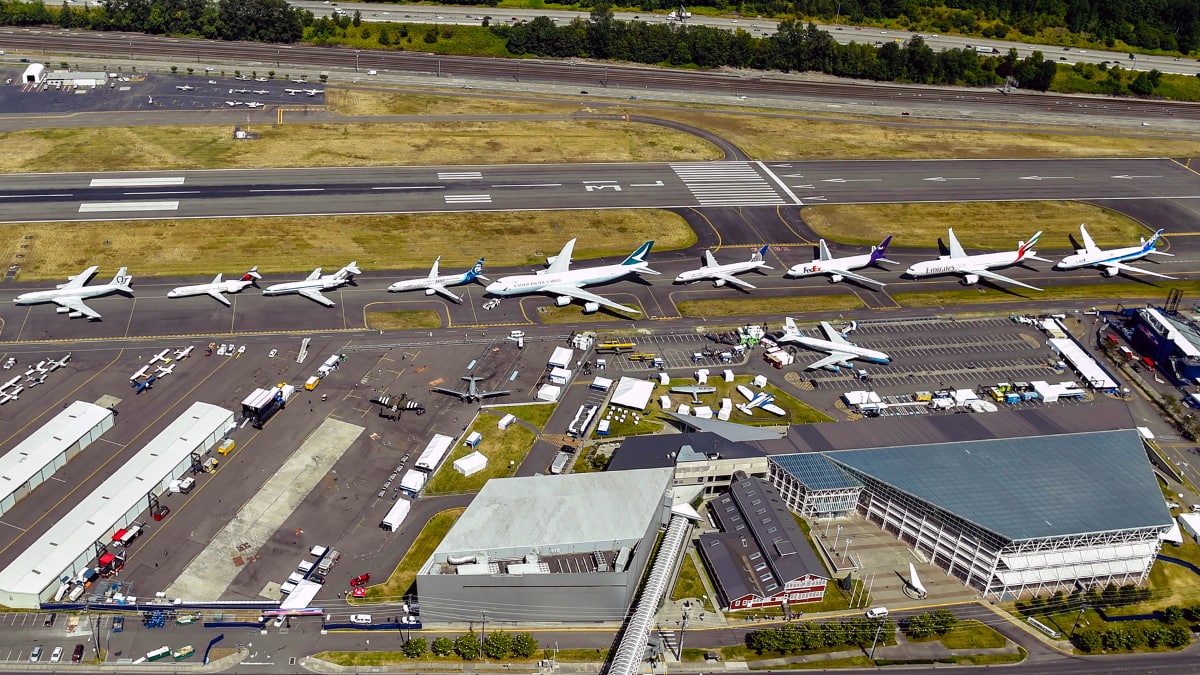Asia-Pacific is driving demand for new aircraft. Aviation traffic in the region is expected to grow by 4.7% annually and reach 3.1 billion passengers by 2035. Aircraft manufacturers – both global players as well as local ones – profit from the expanding operations of Asian airlines to keep up with the rising demand.
Commercial aircraft industry dominated by a few
With thousands of aircraft flying worldwide on a daily basis, it might come as a surprise that only a few companies are building these vessels. The top players in the commercial aircraft industry are Airbus and Boeing.
Both are competing head-to-head: Last year, Boeing produced about 20 more aircraft than Airbus, making the company the world’s biggest commercial aircraft manufacturer. In terms of delivery, Boeing delivered 806 aircraft worldwide in 2018. It has increased the production of 737 types to 52 aeroplanes per month, and continues to build the 787 Dreamliner, with 145 deliveries in 2018. Rival Airbus delivered 800 commercial aircraft to 93 customers last year, up 11% compared to the previous year. Airbus received 747 net orders in 2018, increasing the backlog of commercial aircraft to 7,577.
For both companies, Asia-Pacific has become the priority market. According to Boeing’s Current Market Outlook, the Asia-Pacific region will receive 17,390 deliveries between 2019 and 2038. The total fleet is expected to rise to 19,420 aircraft by 2038, with a service market volume of nearly $3.5 billion. In comparison, Europe and North America combined are forecasted to receive around 18,100 deliveries and a combined fleet of about 20,200. Combined service market volume is estimated to reach nearly $3 billion.
Meanwhile, Airbus’ 2018-2037 Global Market Forecast predicts 15,640 new deliveries for Asia-Pacific within this period. This means Asia-Pacific will account for 42% of deliveries worldwide. In comparison, airlines in North America and Europe together account for 35% of the passenger aircraft deliveries.
Asian airlines filling Boeing’s and Airbus’ order books
At the 2019 Paris Air Show, Malaysian low-cost leader AirAsia announced that they are converting an order for 253 A320-200neos to the larger A321-200neo. This officially made the group Airbus’ largest customer of this aircraft type, which has a 180-220 seating capacity.
Also, the Philippines’ Cebu Pacific plans to grow its seat capacity by 15% in 2019. Cebu has ordered 31 aircraft from Airbus in a deal worth $6.8 billion, accelerating its plan to replace its current fleet of 72 aeroplanes in five years.
Meanwhile, Japan’s ANA Holdings Inc. said last January that it would order a total of 48 aircraft, including 30 Boeing 737 MAX 8 and 18 Airbus A320neo, for delivery in 2021-2025. “The decision was based on the economic growth of Asia and emerging countries, with demand in the Asian aviation market and inbound demand on the rise,” it said, concerning their latest orders.
Aircraft manufacturers: Shifting production to Asia
As demand for aircraft grows rapidly in Asia, global aircraft manufacturers are opening new production sites in the region.
In December 2018, Boeing opened its first 737 completion and delivery centre in Zhoushan, China, after more than a year of construction. The facility will put the finishing touches on planes built in the U.S. prior to delivery to local customers. Around 25% of Boeing orders are bound for China, and the country’s airlines are the biggest customers of Boeing 737s.
Meanwhile, Airbus has been assembling its A320s in China for about a decade. In 2017, Airbus expanded its Tianjin campus to include a completion and delivery centre for its wide-body A330s.
Furthermore, Southeast Asia is becoming an important region for maintenance, repair and overhaul. In 2018, the ASEAN region recorded around $14 billion worth of aircraft parts and related services.
Local champions in the Asian aviation industry
In addition to the two worldwide leaders, Boeing and Airbus, Asian aircraft manufactures are also on the rise.
For the past decade, China has been developing its own planes to challenge the dominance of Western manufacturers in the sector. China founded the Commercial Aircraft Corporation of China (COMAC) in 2008, which has already built two jets: the 90-seat ARJ21 and the 168-seat C919. The latter will become China’s first large passenger jet and was designed to compete with Airbus’ A320neo. The third test flight of C919 was completed last December. Its first deliveries are scheduled for 2021. In total, COMAC has secured 785 orders from 27 foreign and domestic customers. These include Air China and leasing company GE Capital Aviation Service.
Meanwhile, Japan’s Mitsubishi Aircraft Corporation is working on its 90-seat SpaceJet M90 project. After years of delay, the aircraft is supposed to go into service with Japanese carrier All Nippon Airways next year. As for SpaceJet M100, it is due to be ready by 2023.
Mitsubishi Aircraft aims to grow commercial aviation into its main revenue source in 10-20 years. Over the next two decades, the company expects demand for more than 5,000 regional jets, mostly replacement demand.
In addition, Mitsubishi Aircraft is one of Boeing’s main suppliers. The company manufactures the wings for the Boeing 787.










 Australia
Australia China
China India
India Indonesia
Indonesia Japan
Japan Malaysia
Malaysia Philippines
Philippines Singapore
Singapore South Korea
South Korea Taiwan
Taiwan Thailand
Thailand Vietnam
Vietnam Germany
Germany Hong Kong
Hong Kong USA
USA Switzerland
Switzerland Singapore
Singapore
 United Kingdom
United Kingdom








